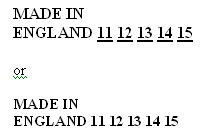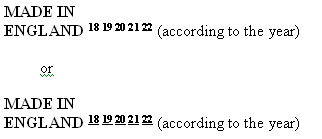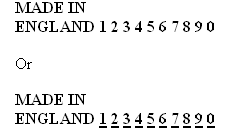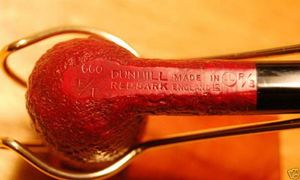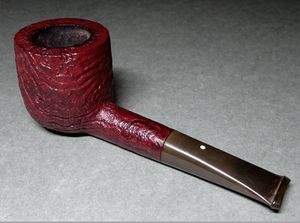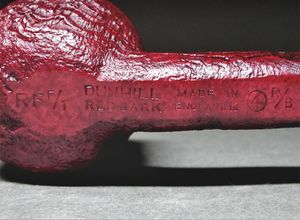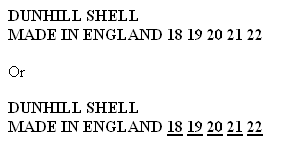A Dunhill Pipe Dating Guide/fr: Difference between revisions
(Created page with "3. '''Shell''' - introduite en 1917") |
(Created page with "4. '''Tanshell''' - introduite en 1953") |
||
| Line 26: | Line 26: | ||
3. '''Shell''' - introduite en 1917 | 3. '''Shell''' - introduite en 1917 | ||
4. '''Tanshell''' - | 4. '''Tanshell''' - introduite en 1953 | ||
5. '''Redbark''' -introduced in 1973. ('''''Pipedia Sysop note:''''' Other sources indicate the Redbark was introduced in 1972 [http://pipedia.org/index.php?title=Image:Dunhill72RB.jpg See example]). | 5. '''Redbark''' -introduced in 1973. ('''''Pipedia Sysop note:''''' Other sources indicate the Redbark was introduced in 1972 [http://pipedia.org/index.php?title=Image:Dunhill72RB.jpg See example]). | ||
Revision as of 02:06, 8 August 2019
Publié à l’origine dans Pipe Smoker, Hiver 1984, avec une partie de ce guide re-publiée dans le numéro du Printemps 2005 de Pipes and Tobaccos. Republié ici avec la permission de l’auteur.
Please note: Scanning the text from the original article has presented problems, some of which I have not been able to solve. Much of the spacing in this presentation is not as intended.
Guide de datation des pipes Dunhill
Alfred Dunhill commença à fabriquer des pipes de bruyère en 1910 ; le célèbre point blanc apparut tout d’abord sur le dessus des tuyaux d’ébonite taillés main en 1915, afin que le client sache quel côté du tuyau mettre au-dessus. A peu près en même temps une garantie d’un an couvrant tout défaut sur chaque tête de pipe fut offerte, et pour s’assurer qu’aucune pipe plus ancienne ne serait remplacée au titre de cette garantie, on conçut un simple code date, retraçant l’année de fabrication, qui fut frappé sur chaque tête de pipe. Ce code est toujours utilisé aujourd’hui.
Dans les années qui suivirent on vit naître un grand intérêt pour la “mystique” des pipes Dunhill en général et le système de codage des dates en particulier. Les collectionneurs de pipes, particulièrement en Amérique, s’enorgueillissent de l’acquisition de Dunhill en excellent état qui ont été fabriquées dans les années 20, les années 30 ou les années 40. Certains collectionneurs s’efforcent d’acquérir uniquement les Dunhill fabriquées entre 1920 (lorsque Dunhill arrêta d’acheter des têtes de pipes tournées en France au profit de celles tournées à Londres dans l’unité de tournage Dunhill fraîchement ouverte) et 1928 (l’année où Alfred Dunhill prit sa retraite). Par conséquent, il en est résulté beaucoup de confusion à propos du codage des dates, car celui-ci n’avait pas été standardisé au fil des années, et une différence d’apparence minime dans le code peut signifier une différence d’années, voire de décennies, dans la fabrication de la pipe.
S’ajoute à cela le fait que l’entreprise a utilisé un grand nombre de marquages spéciaux selon la partie du monde à laquelle les pipes étaient destinées, et que parfois ces marquages ou ces codes ne furent utilisés que durant trois ou quatre mois.
Pour ajouter encore à la confusion, de nombreuses pipes furent tout simplement marquées de façon incorrecte; certaines fois une partie ou l’autre du code n’apparaît pas sur une pipe donnée.
En prenant tout ceci en compte, on ne doit pas être surpris que la liste originale et complète des codes de date, qui est en possession de l’archiviste de l’entreprise du 30, Duke Street, fasse quelques 28 pages. Et même si cette liste était disponible, elle serait de peu d’utilité, excepté pour les plus experts, car elle n’est utilisable qu’en possédant une connaissance des plus précises des pipes Dunhill, l’apparence de celles-ci ayant changé au cours des années.
Mais c’est assez sur la complexité de datation des Dunhill. Ce qui suit est un “guide général” de datation ; avec lui le lecteur sera capable de dater la majorité des Dunhill qu’il ou elle rencontrera.
Types de finition
1. Bruyere - introduite en 1910, désigné par un ”A” (qui signifiait « qualité la meilleure») sur le côté de la tige jusqu’en 1975. « Inner Tube » sera marqué sur la tige jusqu’en 1934.
2. Root - introduite en 1930, désignée par un “R” marqué sur la tige jusqu’en 1975.
3. Shell - introduite en 1917
4. Tanshell - introduite en 1953
5. Redbark -introduced in 1973. (Pipedia Sysop note: Other sources indicate the Redbark was introduced in 1972 See example).
6. Cumberland -introduced in 1980.
Special series:
H.W. "hand, worked" - A hand-carved (as opposed to machine-carved) pipe of classic design. "H.W." stamped on shank. Not made after 1930's.
D. R. "dead root" - Denotes Dunhill straight grain pipes. The bruyere finish was used on these pipes through 1929; root finish was used thereafter. "D.R." stamped on shank.
O.D. "own design" - Denotes a pipe designed by the customer and carved to order. "O.D." stamped on shank. Not made after late 1920's or early 1930's. In 1950 a special series of "ODA" pipes was begun and continued through 1975. These were not carved to order.
Collector - Denotes hand-turned bowls (as opposed to machine-turned) made from plateau briar. Introduced in 1978.
Dating of Bruyere and Root finishes - 1925 onwards
1925:
NOTE: For the years 1925 through 1941 the suffix number (denoting the year of manufacture) is sometimes after the patent number and sometimes after the word ENGLAND.
1926-34: As above but with annual change of suffix number 6(1926) 7(1927) 8(1928) 9(1929) 0(1930) 11(1931) 12(1932) 13(1933) 14(1934).
NOTE: For the years 1925-34 other patent numbers were sometimes used in place of 116989/17. Some examples are: 5861/12 (English); 1343253/20 (U.S.)
1935-41:
1942-50:
1951: As above but with the suffix1 after the word ENGLAND; in addition a group number e.g. 4 R or 3 A is introduced for the first time.
1952: As above but with the suffix2 after the word ENGLAND. Also, instead of DUNHILL/LONDON the finish of the pipe is stamped under the word Dunhill e.g. DUNHILL/ROOT BRIAR
1953-54: As above but with 3 or 4 as suffix according to the year made.
1955-60: From 1955 the patent number is no longer shown on the pipe. Examples for this period read:
1961-70: Same as above but with the line under the suffix number omitted. In addition from 1965-70 the size of the suffix number is the same as the D in ENGLAND.
1971-75: As above but with a double suffix number (sometimes underlined).
1976-77: During this period the group number and finish code were dropped and the old shape numbers were dropped in favor of a new system. Shape numbers during this period had either 3, 4, or 5 digits.
1978-82: In 1978 shape numbers all became five digit. Also the double digit suffix number (sometimes underlined) again became smaller than the D in ENGLAND.
Dating of Shell, Tanshell, Redbark, and Cumberland finishes-1925 onwards:
1925:
1926-34: As above but with annual change of suffix number 6 (1926) 7 (1927) 8 (1928) 9 (1929) 0 (1930) 11 (1931) 12 (1932) 13 (1933) 14 (1934)
NOTE: For the years 1925-34 other patent numbers were sometimes used in place of 119708/17 & 116989/17. Some examples are: 5861/12 (English); 1341418/20 (U.S.); 1130806/15 (U.S.); 1343253/20 U.S.); 1861910/32 (U.S. - used only for Vernon Dunhill fitment pipe).
1935-41:
1942-50:
1951: As above but with the suffix after the word ENGLAND; in addition a group number e.g. 2 S; 4 S is introduced for the first time.
1952:
1953-54: The Tanshell finish is introduced in 1953. As above but with the suffix3 or 4 after the word ENGLAND.
1955-60: From 1955 the patent number is no longer shown on the pipe.
1961-70: As above, but with the line under the suffix number omitted. From 1965-70 the size of the suffix number is the same as the D in ENGLAND.
1971-75 As above, but with a double digit suffix number (sometimes underlined). It had been widely report that The Redbark is introduced in 1973, but we have examples that date to 1972 as seen bellow.
- Redbarks with 1972 nomenclature
1976-77: During this period the group number and finish code were dropped and the old shape numbers were dropped in favor of a new system. Shape numbers during this period had either 3, 4, or 5 digits.
1978-82: In 1978 shape numbers all became five digit. Also the double digit suffix number (sometimes underlined) again became smaller than the D in ENGLAND. The Cumberland finish is introduced in 1980.
Dating the Pre 1925 Dunhill Pipe
The guide above is very helpful, but there are discrepancies in both the literature regarding the nomenclature, and anomalies in the nomenclature itself. We highly recommend the book by Dunhill expert, John C. Loring called, "The Dunhill Briar Pipe - 'the patent years and after'. Unfortunately, John passed away several years ago, and his website has recently disappeared. Fortunately, the following article was saved by Doug Valitchka, who has made it available here on Pipedia. It is especiall helpful when dating Pre 1925 Dunhills:



